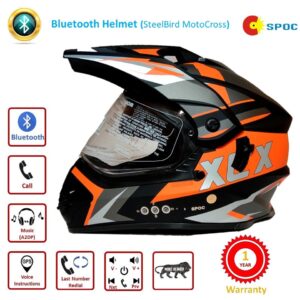Introduction
Smart helmets represent the convergence of cutting-edge technology with traditional safety gear, offering a glimpse into the future of protective headwear. As advancements continue to push the boundaries of innovation, these helmets are poised to revolutionize safety, connectivity, and user experience in various fields, from sports and recreation to industrial work and transportation.
1. Enhanced Safety Features:
- Intelligent Impact Detection:
- Future smart helmets will incorporate advanced sensors capable of detecting and analyzing impacts in real-time.
- These sensors will provide precise data on the force and direction of impacts, allowing for immediate response and assistance in the event of accidents.
- Adaptive Protection Systems:
- Smart helmets will feature adaptive protection systems that adjust their level of protection based on the severity of impacts
- This could involve materials that dynamically change their properties upon impact or deployable airbag systems to mitigate force
- Integrated Emergency response:
- In the event of an accident, smart helmets will automatically trigger emergency alerts to predefined contacts or emergency services.
- GPS tracking and communication capabilities will enable swift response and rescue operations, potentially saving lives.
2. Seamless Connectivity:
- Integrated Communication Systems:
- Smart helmets will incorporate built-in communication systems, allowing wearers to make hands-free calls, send messages, and access navigation information.
- These systems will enhance safety and convenience by minimizing distractions and reducing the need to interact with external devices.
- IoT Integration:
- Smart helmets will seamlessly connect with the Internet of Things (IoT) ecosystem, enabling interaction with smart vehicles, infrastructure, and wearable devices.
- This connectivity will facilitate real-time data exchange, traffic monitoring, and enhanced situational awareness for wearers.
- Cloud Connectivity:
- Cloud-based services will enable remote management and customization of smart helmet settings, firmware updates, and data analytics.
- Wearers will have access to personalized insights, performance metrics, and community features through cloud-connected platforms.
3. Innovative Design and Materials:
- Lightweight and Durable Construction:
- Future smart helmets will leverage advanced materials such as carbon fiber composites and grapheme to achieve optimal strength-to-weight ratios.
- These lightweight yet durable materials will enhance comfort and protection without compromising performance.
- Modular and Customizable Features:
- Smart helmets will adopt modular designs that allow for easy customization and upgradeability.
- Wearers will have the flexibility to add or remove components such as visors, communication modules, and sensors to suit their specific needs.
4. Augmented Reality (AR) Integration:
- Heads-Up Display (HUD):
- Smart helmets will incorporate heads-up display (HUD) systems that overlay relevant information directly within the wearer’s field of view.
- This technology will provide real-time data on speed, navigation, and environmental conditions, enhancing situational awareness and safety.
- AR Visualization:
- Augmented reality (AR) features will enable interactive visualization of routes, points of interest, and hazard warnings through the helmet’s visor.
- Wearers will benefit from immersive experiences that enhance navigation, training, and exploration activities.
5. Customizable Voice Commands:
Personalized Settings and Preferences:
- Users can customize voice commands to suit their specific needs, preferences, and workflows.
- This customization enables users to tailor the helmet’s functionality to their individual requirements, enhancing usability and user satisfaction.
- Multi-Language Support:
- Voice-activated smart helmets can support multiple languages, catering to users from diverse backgrounds and regions.
- This inclusivity ensures that all users can interact with the helmet effectively, regardless of their linguistic abilities.
Conclusion:
Voice-activated smart helmets represent a paradigm shift in protective headwear, offering unprecedented levels of safety, connectivity, and user experience. With hands-free operation, seamless connectivity, customizable voice commands, and integration with augmented reality, these helmets are poised to redefine the standards of personal protective equipment across various industries. As technology continues to evolve, voice-activated smart helmets will undoubtedly play a pivotal role in enhancing safety, productivity, and user satisfaction in a rapidly changing world.

